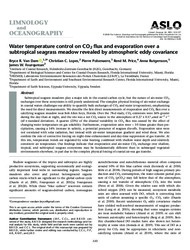Water temperature control on CO2 flux and evaporation over a subtropical seagrass meadow revealed by atmospheric eddy covariance
Lopes, Christian C.
Price, René M.
Fourqurean, James W.
Van Dam, Bryce R.; Lopes, Christian C.; Polsenaere, Pierre; Price, René M.; Rutgersson, Anna; Fourqurean, James W., 2020: Water temperature control on CO2 flux and evaporation over a subtropical seagrass meadow revealed by atmospheric eddy covariance. In: Limnology and Oceanography, Band 66, 2: 510 - 527, DOI: 10.23689/fidgeo-4210.
 |
Dokument öffnen: |
Subtropical seagrass meadows play a major role in the coastal carbon cycle, but the nature of air–water CO2 exchanges over these ecosystems is still poorly understood. The complex physical forcing of air–water exchange in coastal waters challenges our ability to quantify bulk exchanges of CO2 and water (evaporation), emphasizing the need for direct measurements. We describe the first direct measurements of evaporation and CO2 flux over a calcifying seagrass meadow near Bob Allen Keys, Florida. Over the 78‐d study, CO2 emissions were 36% greater during the day than at night, and the site was a net CO2 source to the atmosphere of 0.27 ± 0.17 μmol m−2 s−1 (x̅ ± standard deviation). A quarter (23%) of the diurnal variability in CO2 flux was caused by the effect of changing water temperature on gas solubility. Furthermore, evaporation rates were ~ 10 times greater than precipitation, causing a 14% increase in salinity, a potential precursor of seagrass die‐offs. Evaporation rates were not correlated with solar radiation, but instead with air–water temperature gradient and wind shear. We also confirm the role of convective forcing on night‐time enhancement and day‐time suppression of gas transfer. At this site, temperature trends are regulated by solar heating, combined with shallow water depth and relatively consistent air temperature. Our findings indicate that evaporation and air–water CO2 exchange over shallow, tropical, and subtropical seagrass ecosystems may be fundamentally different than in submerged vegetated environments elsewhere, in part due to the complex physical forcing of coastal air–sea gas transfer.
Statistik:
ZugriffsstatistikSammlung:
Schlagworte:
FloridaBob Allen Keys
seagrass meadows
air–water CO2 exchanges
biometeorological measurements
This is an open access article under the terms of the Creative Commons Attribution License, which permits use, distribution and reproduction in any medium, provided the original work is properly cited.

